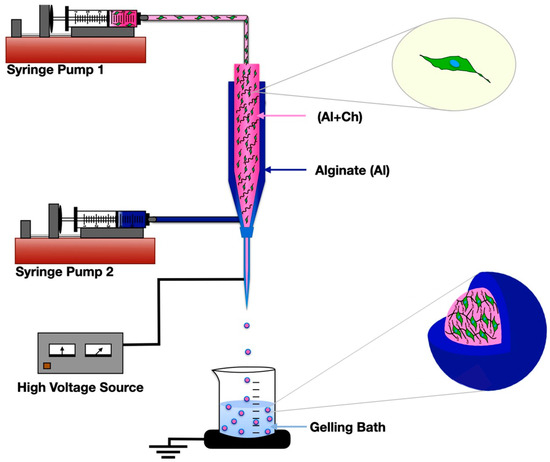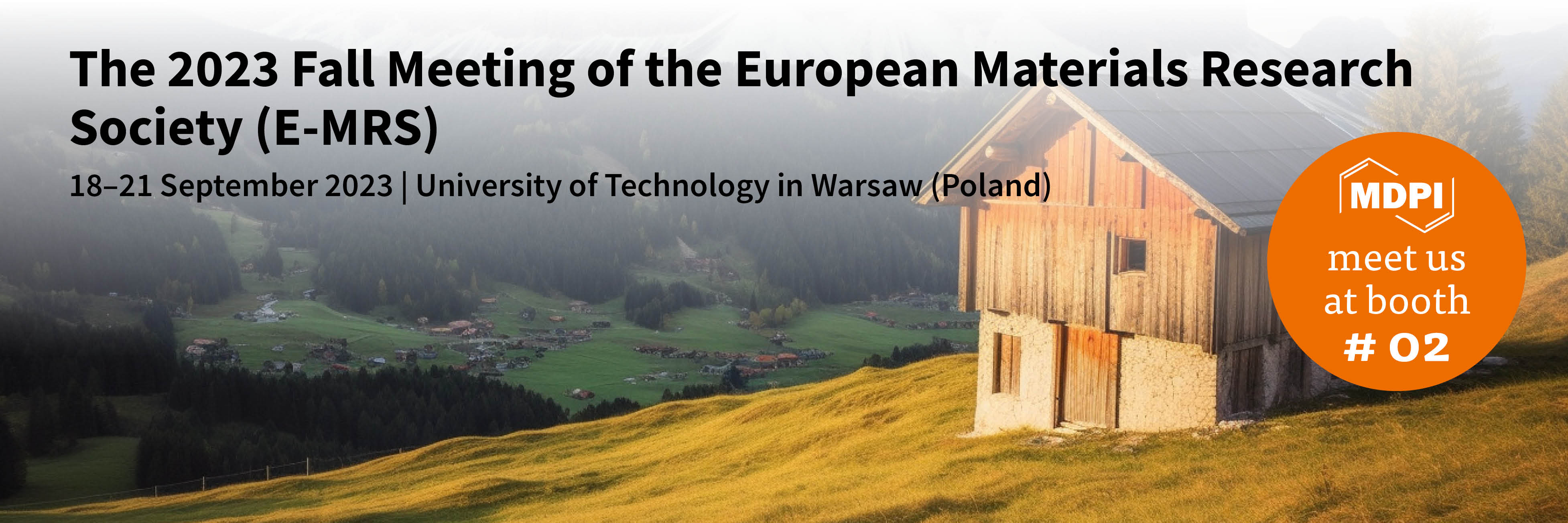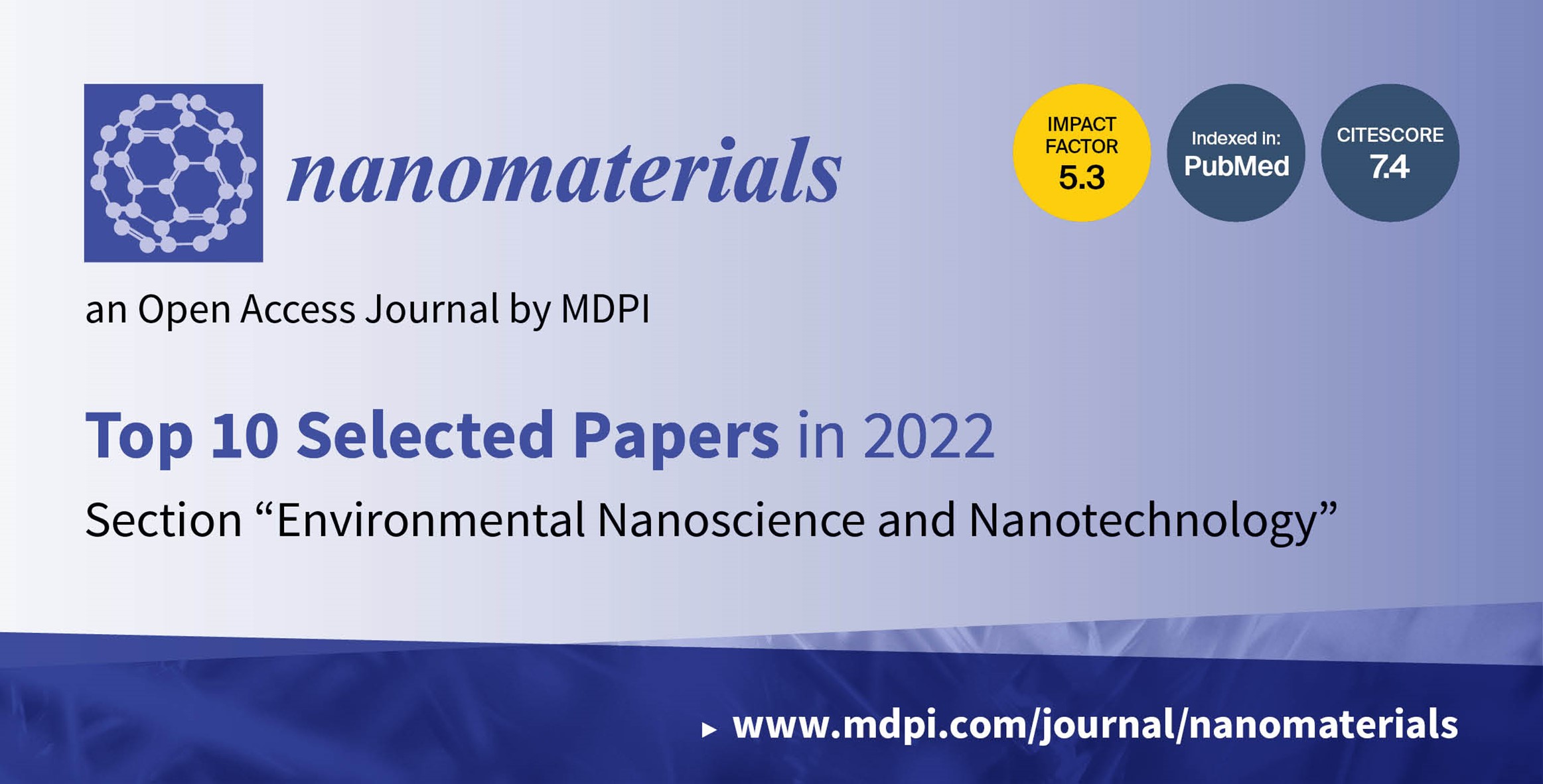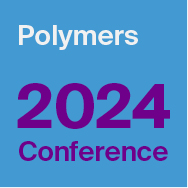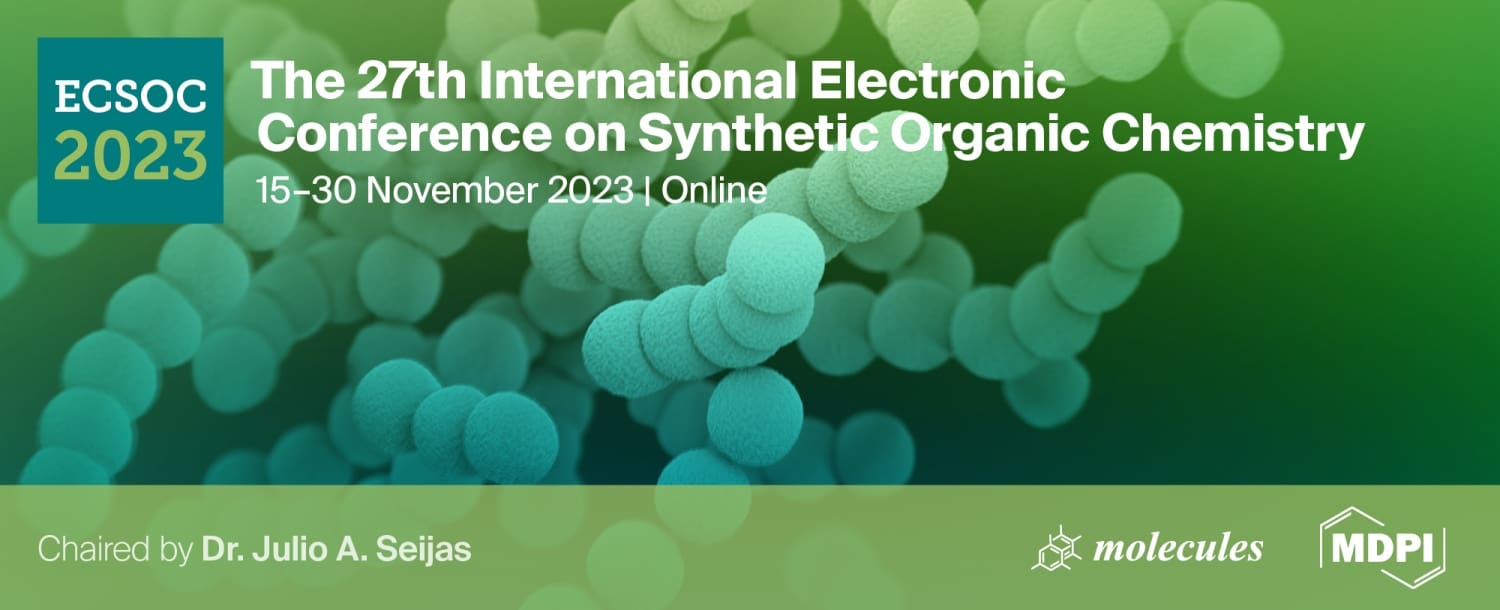-
 Recent Advances in Tunable Metasurfaces and Their Application in Optics
Recent Advances in Tunable Metasurfaces and Their Application in Optics -
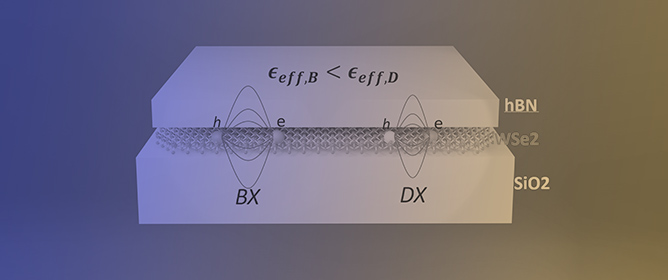 The Key Role of Non-Local Screening in the Environment-Insensitive Exciton Fine Structures of Transition-Metal Dichalcogenide Monolayers
The Key Role of Non-Local Screening in the Environment-Insensitive Exciton Fine Structures of Transition-Metal Dichalcogenide Monolayers -
 Transition from AFM Spin Canting to Spin Glass–AFM Exchange as Particle Size Decreases in LaFeO3
Transition from AFM Spin Canting to Spin Glass–AFM Exchange as Particle Size Decreases in LaFeO3
Journal Description
Nanomaterials
Nanomaterials
is an international, peer-reviewed, open access journal published semimonthly online by MDPI.
- Open Access— free for readers, with article processing charges (APC) paid by authors or their institutions.
- High Visibility: indexed within Scopus, SCIE (Web of Science), PubMed, PMC, CAPlus / SciFinder, Inspec, and other databases.
- Journal Rank: JCR - Q1 (Physics, Applied) / CiteScore - Q1 (General Chemical Engineering)
- Rapid Publication: manuscripts are peer-reviewed and a first decision is provided to authors approximately 11.7 days after submission; acceptance to publication is undertaken in 2.6 days (median values for papers published in this journal in the first half of 2023).
- Recognition of Reviewers: reviewers who provide timely, thorough peer-review reports receive vouchers entitling them to a discount on the APC of their next publication in any MDPI journal, in appreciation of the work done.
- Companion journals for Nanomaterials include: Nanomanufacturing and Applied Nano.
Impact Factor:
5.3 (2022);
5-Year Impact Factor:
5.4 (2022)
Latest Articles
Chitin Nanofibrils Enabled Core–Shell Microcapsules of Alginate Hydrogel
Nanomaterials 2023, 13(17), 2470; https://doi.org/10.3390/nano13172470 (registering DOI) - 01 Sep 2023
Abstract
An engineered 3D architectural network of the biopolymeric hydrogel can mimic the native cell environment that promotes cell infiltration and growth. Among several bio-fabricated hydrogel structures, core–shell microcapsules inherit the potential of cell encapsulation to ensure the growth and transport of cells and
[...] Read more.
An engineered 3D architectural network of the biopolymeric hydrogel can mimic the native cell environment that promotes cell infiltration and growth. Among several bio-fabricated hydrogel structures, core–shell microcapsules inherit the potential of cell encapsulation to ensure the growth and transport of cells and cell metabolites. Herein, a co-axial electrostatic encapsulation strategy is used to create and encapsulate the cells into chitin nanofibrils integrated alginate hydrogel microcapsules. Three parameters that are critical in the electrostatic encapsulation process, hydrogel composition, flow rate, and voltage were optimized. The physicochemical characterization including structure, size, and stability of the core–shell microcapsules was analyzed by scanning electron microscope (SEM), FTIR, and mechanical tests. The cellular responses of the core–shell microcapsules were evaluated through in vitro cell studies by encapsulating NIH/3T3 fibroblast cells. Notably, the bioactive microcapsule showed that the cell viability was found excellent for more than 2 weeks. Thus, the results of this core–shell microcapsule showed a promising approach to creating 3D hydrogel networks suitable for different biomedical applications such as in vitro tissue models for toxicity studies, wound healing, and tissue repair.
Full article
(This article belongs to the Section Nanocomposite Materials)
►
Show Figures
Open AccessArticle
Ambipolar to Unipolar Conversion in C70/Ferrocene Nanosheet Field-Effect Transistors
by
, , , , , , , , , , , and
Nanomaterials 2023, 13(17), 2469; https://doi.org/10.3390/nano13172469 (registering DOI) - 01 Sep 2023
Abstract
Organic cocrystals, which are assembled by noncovalent intermolecular interactions, have garnered intense interest due to their remarkable chemicophysical properties and practical applications. One notable feature, namely, the charge transfer (CT) interactions within the cocrystals, not only facilitates the formation of an ordered supramolecular
[...] Read more.
Organic cocrystals, which are assembled by noncovalent intermolecular interactions, have garnered intense interest due to their remarkable chemicophysical properties and practical applications. One notable feature, namely, the charge transfer (CT) interactions within the cocrystals, not only facilitates the formation of an ordered supramolecular network but also endows them with desirable semiconductor characteristics. Here, we present the intriguing ambipolar CT properties exhibited by nanosheets composed of single cocrystals of C70/ferrocene (C70/Fc). When heated to 150 °C, the initially ambipolar monoclinic C70/Fc nanosheet-based field-effect transistors (FETs) were transformed into n-type face-centered cubic (fcc) C70 nanosheet-based FETs owing to the elimination of Fc. This thermally induced alteration in the crystal structure was accompanied by an irreversible switching of the semiconducting behavior of the device; thus, the device transitions from ambipolar to unipolar. Importantly, the C70/Fc nanosheet-based FETs were also found to be much more thermally stable than the previously reported C60/Fc nanosheet-based FETs. Furthermore, we conducted visible/near-infrared diffuse reflectance and photoemission yield spectroscopies to investigate the crucial role played by Fc in modulating the CT characteristics. This study provides valuable insights into the overall functionality of these nanosheet structures.
Full article
(This article belongs to the Special Issue Semiconductor Nanomaterials: Growth, Characterization and Optoelectronic Application)
►▼
Show Figures

Figure 1
Open AccessArticle
Effect of Exposure Concentration and Growth Conditions on the Association of Cerium Oxide Nanoparticles with Green Algae
by
, , , and
Nanomaterials 2023, 13(17), 2468; https://doi.org/10.3390/nano13172468 (registering DOI) - 01 Sep 2023
Abstract
The increasing release of engineered nanoparticles (NPs) into aquatic ecosystems makes it crucial to understand the interactions of NPs with aquatic organisms, such as algae. In this study, the association of CeO2 NPs with unicellular algae (Raphidocelis subcapitata) and changes
[...] Read more.
The increasing release of engineered nanoparticles (NPs) into aquatic ecosystems makes it crucial to understand the interactions of NPs with aquatic organisms, such as algae. In this study, the association of CeO2 NPs with unicellular algae (Raphidocelis subcapitata) and changes to the cellular elemental profile were investigated using three exposure concentrations (1, 50, and 1000 µg CeO2/L) at two different algal growth conditions—exponential and inhibited growth (1% glutaraldehyde). After a 24 h-exposure, algal suspensions were settled by gravity and CeO2-NP/algae association was analyzed by single-cell inductively coupled plasma quadrupole mass spectrometry (sc-ICP-QMS) and ICP time-of-flight MS (sc-ICP-TOFMS). Concurrent detection of the cellular fingerprint with cerium indicated NP association with algae (adsorption/uptake) and changes in the cellular elemental profiles. Less than 5% of cells were associated with NPs when exposed to 1 µg/L. For 50 µg/L exposures in growing and inhibited cell treatments, 4% and 16% of cells were associated with CeO2 NPs, respectively. ICP-TOFMS analysis made it possible to exclude cellular exudates associated with CeO2 NPs due to the cellular fingerprint. Growing and inhibited cells had different elemental profile changes following exposure to CeO2 NPs—e.g., growing cells had higher Mg and lower P contents independent of CeO2 concentration compared to inhibited cells.
Full article
(This article belongs to the Special Issue Ecotoxicity Assessment of Nanomaterials: Latest Advances and Prospects)
►▼
Show Figures
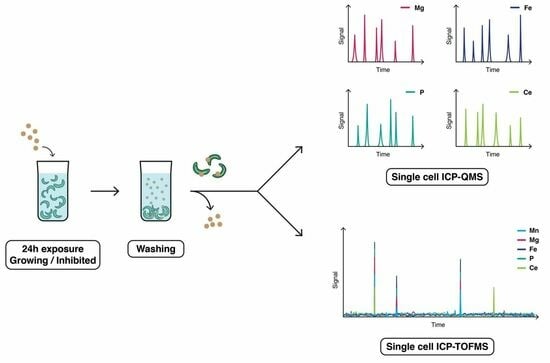
Graphical abstract
Open AccessArticle
Facile Transfer of Spray-Coated Ultrathin AgNWs Composite onto the Skin for Electrophysiological Sensors
Nanomaterials 2023, 13(17), 2467; https://doi.org/10.3390/nano13172467 (registering DOI) - 31 Aug 2023
Abstract
Disposable wearable sensors that ultrathin and conformable to the skin are of significant interest as affordable and easy-to-use devices for short-term recording. This study presents a facile and low-cost method for transferring spray-coated silver nanowire (AgNW) composite films onto human skin using glossy
[...] Read more.
Disposable wearable sensors that ultrathin and conformable to the skin are of significant interest as affordable and easy-to-use devices for short-term recording. This study presents a facile and low-cost method for transferring spray-coated silver nanowire (AgNW) composite films onto human skin using glossy paper (GP) and liquid bandages (LB). Due to the moderately hydrophobic and rough surface of the GP, the ultrathin AgNWs composite film (~200 nm) was easily transferred onto human skin. The AgNW composite films conformally attached to the skin when applied with a LB, resulting in the stable and continuous recording of wearable electrophysiological signals, including electromyogram (EMG), electrocardiogram (ECG), and electrooculogram (EOG). The volatile LB, deposited on the skin via spray coating, promoted rapid adhesion of the transferred AgNW composite films, ensuring stability to the AgNWs in external environments. The AgNWs composite supported with the LB film exhibited high water vapor breathability (~28 gm−2h−1), which can avoid the accumulation of sweat at the skin–sensor interface. This approach facilitates the creation of rapid, low-cost, and disposable tattoo-like sensors that are practical for extended use.
Full article
(This article belongs to the Special Issue Advanced Nanomaterials for Soft and Wearable Electronics)
►▼
Show Figures
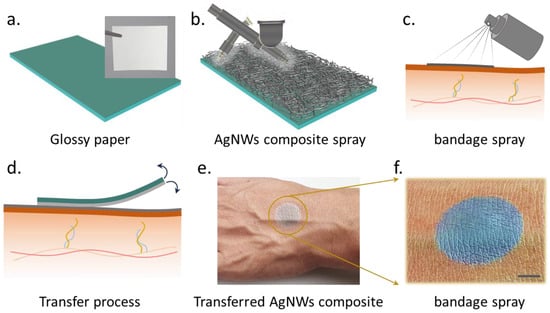
Figure 1
Open AccessReview
Lasing from Micro- and Nano-Scale Photonic Disordered Structures for Biomedical Applications
Nanomaterials 2023, 13(17), 2466; https://doi.org/10.3390/nano13172466 - 31 Aug 2023
Abstract
A disordered photonic medium is one in which scatterers are distributed randomly. Light entering such media experiences multiple scattering events, resulting in a “random walk”-like propagation. Micro- and nano-scale structured disordered photonic media offer platforms for enhanced light–matter interaction, and in the presence
[...] Read more.
A disordered photonic medium is one in which scatterers are distributed randomly. Light entering such media experiences multiple scattering events, resulting in a “random walk”-like propagation. Micro- and nano-scale structured disordered photonic media offer platforms for enhanced light–matter interaction, and in the presence of an appropriate gain medium, coherence-tunable, quasi-monochromatic lasing emission known as random lasing can be obtained. This paper discusses the fundamental physics of light propagation in micro- and nano-scale disordered structures leading to the random lasing phenomenon and related aspects. It then provides a state-of-the-art review of this topic, with special attention to recent advancements of such random lasers and their potential biomedical imaging and biosensing applications.
Full article
(This article belongs to the Special Issue Nano-Photonics and Meta-Nanomaterials)
►▼
Show Figures

Figure 1
Open AccessArticle
Self-Healable PEDOT:PSS-PVA Nanocomposite Hydrogel Strain Sensor for Human Motion Monitoring
Nanomaterials 2023, 13(17), 2465; https://doi.org/10.3390/nano13172465 - 31 Aug 2023
Abstract
Strain sensors based on conducting polymer hydrogels are considered highly promising candidates for wearable electronic devices. However, existing conducting polymer hydrogels are susceptible to aging, damage, and failure, which can greatly deteriorate the sensing performance of strain sensors based on these substances and
[...] Read more.
Strain sensors based on conducting polymer hydrogels are considered highly promising candidates for wearable electronic devices. However, existing conducting polymer hydrogels are susceptible to aging, damage, and failure, which can greatly deteriorate the sensing performance of strain sensors based on these substances and the accuracy of data collection under large deformation. Developing conductive polymer hydrogels with concurrent high sensing performance and self-healing capability is a critical yet challenging task to improve the stability and lifetime of strain sensors. Herein, we design a self-healable conducting polymer hydrogel by compositing poly(3,4-ethylenedioxythiophene):polystyrene sulfonate (PEDOT:PSS) nanofibers and poly(vinyl alcohol) (PVA) via both physical and chemical crosslinking. This PEDOT:PSS-PVA nanocomposite hydrogel strain sensor displays an excellent strain monitoring range (>200%), low hysteresis (<1.6%), a high gauge factor (GF = 3.18), and outstanding self-healing efficiency (>83.5%). Electronic skins based on such hydrogel strain sensors can perform the accurate monitoring of various physiological signals, including swallowing, finger bending, and knee bending. This work presents a novel conducting polymer hydrogel strain sensor demonstrating both high sensing performance and self-healability, which can satisfy broad application scenarios, such as wearable electronics, health monitoring, etc.
Full article
(This article belongs to the Special Issue Synthesis and Applications of Conducting Polymer-Based Nanocomposites)
►▼
Show Figures
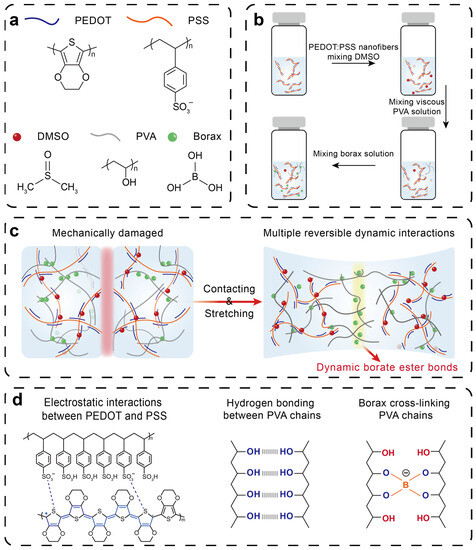
Figure 1
Open AccessArticle
Fabrication and Characterization of Tantalum–Iron Composites for Photocatalytic Hydrogen Evolution
Nanomaterials 2023, 13(17), 2464; https://doi.org/10.3390/nano13172464 - 31 Aug 2023
Abstract
Photocatalytic hydrogen evolution represents a transformative avenue in addressing the challenges of fossil fuels, heralding a renewable and pristine alternative to conventional fossil fuel-driven energy paradigms. Yet, a formidable challenge is crafting a high-efficacy, stable photocatalyst that optimizes solar energy transduction and charge
[...] Read more.
Photocatalytic hydrogen evolution represents a transformative avenue in addressing the challenges of fossil fuels, heralding a renewable and pristine alternative to conventional fossil fuel-driven energy paradigms. Yet, a formidable challenge is crafting a high-efficacy, stable photocatalyst that optimizes solar energy transduction and charge partitioning even under adversarial conditions. Within the scope of this investigation, tantalum–iron heterojunction composites characterized by intricate, discoidal nanostructured materials were meticulously synthesized using a solvothermal-augmented calcination protocol. The X-ray diffraction, coupled with Rietveld refinements delineated the nuanced alterations in phase constitution and structural intricacies engendered by disparate calcination thermal regimes. An exhaustive study encompassing nano-morphology, electronic band attributes, bandgap dynamics, and a rigorous appraisal of their photocatalytic prowess has been executed for the composite array. Intriguingly, the specimen denoted as 1000-1, a heterojunction composite of TaO2/Ta2O5/FeTaO4, manifested an exemplary photocatalytic hydrogen evolution capacity, registering at 51.24 µmol/g, which eclipses its counterpart, 1100-1 (Ta2O5/FeTaO4), by an impressive margin. Such revelations amplify the prospective utility of these tantalum iron matrices, endorsing their candidacy as potent agents for sustainable hydrogen production via photocatalysis.
Full article
(This article belongs to the Special Issue Photocatalytic Ability of Composite Nanomaterials)
►▼
Show Figures
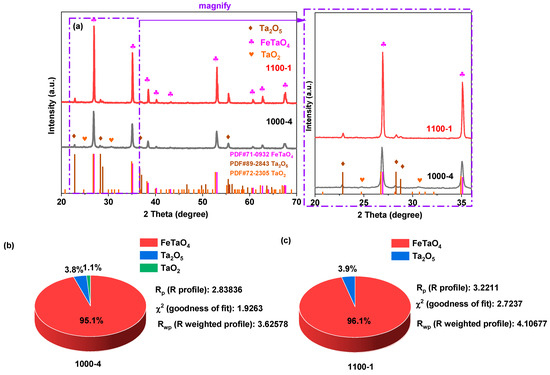
Figure 1
Open AccessArticle
Exploring the Effects of Various Two-Dimensional Supporting Materials on the Water Electrolysis of Co-Mo Sulfide/Oxide Heterostructure
Nanomaterials 2023, 13(17), 2463; https://doi.org/10.3390/nano13172463 - 31 Aug 2023
Abstract
In this study, various two-dimensional (2D) materials were used as supporting materials for the bimetallic Co and Mo sulfide/oxide (CMSO) heterostructure. The water electrolysis activity of CMSO supported on reduced graphene oxide (rGO), graphite carbon nitride (gC3N4), and siloxene
[...] Read more.
In this study, various two-dimensional (2D) materials were used as supporting materials for the bimetallic Co and Mo sulfide/oxide (CMSO) heterostructure. The water electrolysis activity of CMSO supported on reduced graphene oxide (rGO), graphite carbon nitride (gC3N4), and siloxene (SiSh) was better than that of pristine CMSO. In particular, rGO-supported CMSO (CMSO@rGO) exhibited a large surface area and a low interface charge-transfer resistance, leading to a low overpotential and a Tafel slope of 259 mV (10 mA/cm2) and 85 mV/dec, respectively, with excellent long-term stability over 40 h of continuous operation in the oxygen evolution reaction.
Full article
(This article belongs to the Special Issue Advanced Nanostructures for Electrochemical Energy Conversion and Storage)
►▼
Show Figures
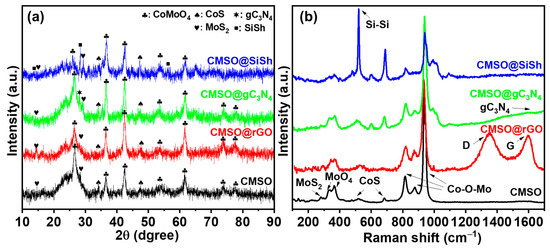
Figure 1
Open AccessArticle
Sol–Gel-Processed Y2O3–Al2O3 Mixed Oxide-Based Resistive Random-Access-Memory Devices
Nanomaterials 2023, 13(17), 2462; https://doi.org/10.3390/nano13172462 - 31 Aug 2023
Abstract
Herein, sol–gel-processed Y2O3–Al2O3 mixed oxide-based resistive random-access-memory (RRAM) devices with different proportions of the involved Y2O3 and Al2O3 precursors were fabricated on indium tin oxide/glass substrates. The corresponding structural, chemical,
[...] Read more.
Herein, sol–gel-processed Y2O3–Al2O3 mixed oxide-based resistive random-access-memory (RRAM) devices with different proportions of the involved Y2O3 and Al2O3 precursors were fabricated on indium tin oxide/glass substrates. The corresponding structural, chemical, and electrical properties were investigated. The fabricated devices exhibited conventional bipolar RRAM characteristics without requiring a high-voltage forming process. With an increase in the percentage of Al2O3 precursor above 50 mol%, the crystallinity reduced, with the amorphous phase increasing owing to internal stress. Moreover, with increasing Al2O3 percentage, the lattice oxygen percentage increased and the oxygen vacancy percentage decreased. A 50% Y2O3–50% Al2O3 mixed oxide-based RRAM device exhibited the maximum high-resistance-state/low-resistance-state (HRS/LRS) ratio, as required for a large readout margin and array size. Additionally, this device demonstrated good endurance characteristics, maintaining stability for approximately 100 cycles with a high HRS/LRS ratio (>104). The HRS and LRS resistances were also retained up to 104 s without considerable degradation.
Full article
(This article belongs to the Special Issue Nanostructures for Integrated Devices)
►▼
Show Figures
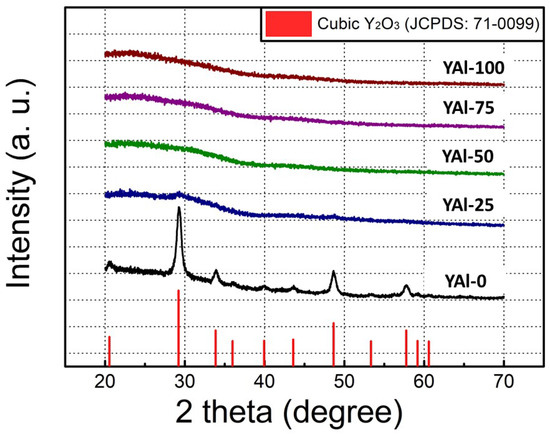
Figure 1
Open AccessArticle
Scalable Synthesis of Oxygen Vacancy-Rich Unsupported Iron Oxide for Efficient Thermocatalytic Conversion of Methane to Hydrogen and Carbon Nanomaterials
by
, , , , and
Nanomaterials 2023, 13(17), 2461; https://doi.org/10.3390/nano13172461 - 31 Aug 2023
Abstract
Thermocatalytic methane decomposition (TCMD) involving metal oxides is a more environmentally friendly and cost-effective strategy for scalable hydrogen fuel production compared to traditional methane steam reforming (MSR), as it requires less energy and produces fewer CO/CO2 emissions. However, the unsupported metal oxide
[...] Read more.
Thermocatalytic methane decomposition (TCMD) involving metal oxides is a more environmentally friendly and cost-effective strategy for scalable hydrogen fuel production compared to traditional methane steam reforming (MSR), as it requires less energy and produces fewer CO/CO2 emissions. However, the unsupported metal oxide catalysts (such as α-Fe2O3) that would be suited for this purpose exhibit poor performance in TCMD. To overcome this issue, a novel strategy was developed as a part of this work, whereby oxygen vacancies (OVs) were introduced into unsupported α-Fe2O3 nanoparticles (NPs). Systematic characterization of the obtained materials through analytical techniques demonstrated that mesoporous nanostructured unsupported α-Fe2O3 with abundant oxygen vacancies (OV-rich α-Fe2O3 NPs) could be obtained by direct thermal decomposition of ferric nitrate at different calcination temperatures (500, 700, 900, and 1100 °C) under ambient conditions. The thermocatalytic activity of the resulting OV-rich α-Fe2O3 NPs was assessed by evaluating the methane conversion, hydrogen formation rate, and amount of carbon deposited. The TCMD results revealed that 900 °C was the most optimal calcination temperature, as it led to the highest methane conversion (22.5%) and hydrogen formation rate (47.0 × 10−5 mol H2 g−1 min−1) after 480 min. This outstanding thermocatalytic performance of OV-rich α-Fe2O3 NPs is attributed to the presence of abundant OVs on their surfaces, thus providing effective active sites for methane decomposition. Moreover, the proposed strategy can be cost-effectively scaled up for industrial applications, whereby unsupported metal oxide NPs can be employed for energy-efficient thermocatalytic CH4 decomposition into hydrogen fuel and carbon nanomaterials.
Full article
(This article belongs to the Special Issue Catalysis of Porous Nanomaterials)
►▼
Show Figures
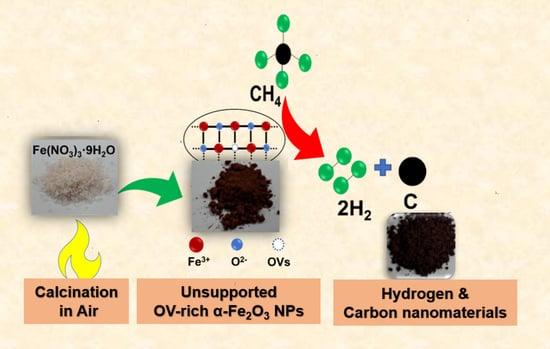
Graphical abstract
Open AccessEditorial
Photonic/Electronic Material Performance and Application Based on Nanocrystals and Nanostructures
Nanomaterials 2023, 13(17), 2460; https://doi.org/10.3390/nano13172460 - 30 Aug 2023
Abstract
Electronic, optoelectronic, and optical devices have become integral to the fabric of the modern life, underpinning critical advancements in information technology, energy utilization, biotechnology, environmental monitoring, and nanotechnology [...]
Full article
(This article belongs to the Special Issue Photonic/Electronic Materials Performance and Application Based on Nanocrystals and Nanostructures)
Open AccessArticle
Microstructure and Oxygen Evolution Property of Prussian Blue Analogs Prepared by Mechanical Grinding
Nanomaterials 2023, 13(17), 2459; https://doi.org/10.3390/nano13172459 (registering DOI) - 30 Aug 2023
Abstract
Solvent-free mechanochemical synthesis of efficient and low-cost double perovskite (DP), like a cage of Prussian blue (PB) and PB analogs (PBAs), is a promising approach for different applications such as chemical sensing, energy storage, and conversion. Although the solvent-free mechanochemical grinding approach has
[...] Read more.
Solvent-free mechanochemical synthesis of efficient and low-cost double perovskite (DP), like a cage of Prussian blue (PB) and PB analogs (PBAs), is a promising approach for different applications such as chemical sensing, energy storage, and conversion. Although the solvent-free mechanochemical grinding approach has been extensively used to create halide-based perovskites, no such reports have been made for cyanide-based double perovskites. Herein, an innovative solvent-free mechanochemical synthetic strategy is demonstrated for synthesizing Fe4[Fe(CN)6]3, Co3[Fe(CN)6]2, and Ni2[Fe(CN)6], where defect sites such as carbon–nitrogen vacancies are inherently introduced during the synthesis. Among all the synthesized PB analogs, the Ni analog manifests a considerable electrocatalytic oxygen evolution reaction (OER) with a low overpotential of 288 mV to obtain the current benchmark density of 20 mA cm−2. We hypothesize that incorporating defects, such as carbon–nitrogen vacancies, and synergistic effects contribute to high catalytic activity. Our findings pave the way for an easy and inexpensive large-scale production of earth-abundant non-toxic electrocatalysts with vacancy-mediated defects for oxygen evolution reaction.
Full article
(This article belongs to the Special Issue Advanced Nanosheets for Carbon Neutrality and Electronic Devices)
►▼
Show Figures

Figure 1
Open AccessArticle
New Eco-Friendly and Low-Energy Synthesis to Produce ZnO Nanoparticles for Real-World Scale Applications
by
, , , , , and
Nanomaterials 2023, 13(17), 2458; https://doi.org/10.3390/nano13172458 - 30 Aug 2023
Abstract
►▼
Show Figures
This paper presents an original and sustainable method for producing ZnO nanoparticles (NPs) in response to global challenges (low energy requirements, low environmental impact, short production times, and high production yield). The method is based on an ion exchange process between an anionic
[...] Read more.
This paper presents an original and sustainable method for producing ZnO nanoparticles (NPs) in response to global challenges (low energy requirements, low environmental impact, short production times, and high production yield). The method is based on an ion exchange process between an anionic resin and an aqueous ZnCl2 solution; it operates in one step at room temperature/ambient pressure without the need for complex apparatus or purification steps. From the kinetics, we observed the formation of pure simonkolleite, a zinc-layered hydroxide salt (Zn5(OH)8Cl2·H2O), after only 5 min of reaction. This compound, used elsewhere as a ZnO precursor after calcination at high temperatures, here decomposes at room temperature into ZnO, allowing extraordinary savings of time and energy. Finally, in only 90 min, pure and crystalline ZnO NPs are obtained, with a production yield > 99%. Several types of aggregates resulting from the self-assembly of small hexagonal platelets (solid or hollow in shape) were observed. Using our revolutionary method, we produced almost 10 kg of ZnO NPs per week without any toxic waste, significantly reducing energy consumption; this method allows transferring the use of these unique NPs from the laboratory environment to the real world.
Full article
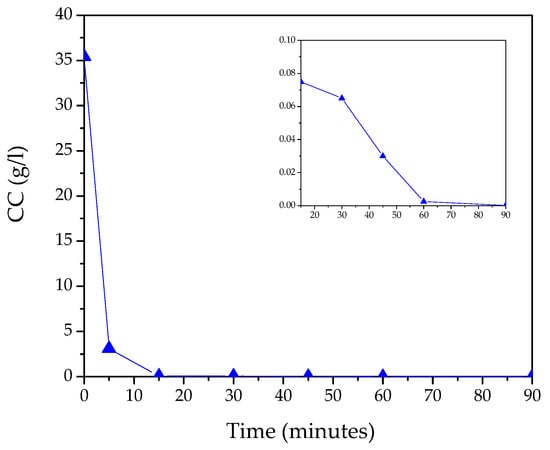
Figure 1
Open AccessArticle
Design, Synthesis, and Characterization of a Novel Blue-Green Long Afterglow BaYAl3O7:Eu2+, Nd3+ Phosphor and Its Anti-Counterfeiting Application
Nanomaterials 2023, 13(17), 2457; https://doi.org/10.3390/nano13172457 - 30 Aug 2023
Abstract
Herein, a series of novel long afterglow nanophosphors BaYAl3O7:Eu2+, Nd3+ was synthesized by the combustion method. The investigation encompassed the characterization of X-ray diffraction, morphology, chemical valence, elemental composition, and photoluminescence behavior of BaYAl
[...] Read more.
Herein, a series of novel long afterglow nanophosphors BaYAl3O7:Eu2+, Nd3+ was synthesized by the combustion method. The investigation encompassed the characterization of X-ray diffraction, morphology, chemical valence, elemental composition, and photoluminescence behavior of BaYAl3O7:Eu2+ and BaYAl3O7:Eu2+, Nd3+ nanoparticles. Under 365 nm excitation, BaYAl3O7:Eu2+ and BaYAl3O7:Eu2+, Nd3+ show emission bands centered at 497 nm and 492 nm, which are attributed to the 4f65d→4f7 transition of Eu2+ ions. The optimal samples of BaYAl3O7:0.03Eu2+ and BaYAl3O7:0.03Eu2+, 0.02Nd3+ have average fluorescence lifetimes of 850 ns and 1149 ns, respectively. The co-doping of Nd3+ ions as the trap centers produced long afterglow luminescence properties, and the afterglow time could reach up to 8 min. Furthermore, the fluorescent powder can be mixed with polyacrylic acid to prepare anti-counterfeiting inks; a clover pattern and snowflake pattern have been successfully printed using screen printing technology, proving its potential application in the field of anti-counterfeiting.
Full article
(This article belongs to the Special Issue Optoelectronic Functional Nanomaterials and Devices)
►▼
Show Figures
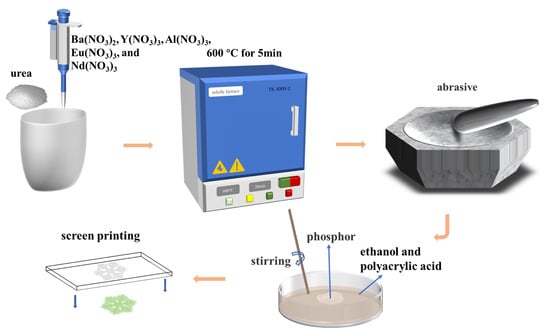
Figure 1
Open AccessReview
Challenges to Optimize Charge Trapping Non-Volatile Flash Memory Cells: A Case Study of HfO2/Al2O3 Nanolaminated Stacks
by
and
Nanomaterials 2023, 13(17), 2456; https://doi.org/10.3390/nano13172456 - 30 Aug 2023
Abstract
The requirements for ever-increasing volumes of data storage have urged intensive studies to find feasible means to satisfy them. In the long run, new device concepts and technologies that overcome the limitations of traditional CMOS-based memory cells will be needed and adopted. In
[...] Read more.
The requirements for ever-increasing volumes of data storage have urged intensive studies to find feasible means to satisfy them. In the long run, new device concepts and technologies that overcome the limitations of traditional CMOS-based memory cells will be needed and adopted. In the meantime, there are still innovations within the current CMOS technology, which could be implemented to improve the data storage ability of memory cells—e.g., replacement of the current dominant floating gate non-volatile memory (NVM) by a charge trapping memory. The latter offers better operation characteristics, e.g., improved retention and endurance, lower power consumption, higher program/erase (P/E) speed and allows vertical stacking. This work provides an overview of our systematic studies of charge-trapping memory cells with a HfO2/Al2O3-based charge-trapping layer prepared by atomic layer deposition (ALD). The possibility to tailor density, energy, and spatial distributions of charge storage traps by the introduction of Al in HfO2 is demonstrated. The impact of the charge trapping layer composition, annealing process, material and thickness of tunneling oxide on the memory windows, and retention and endurance characteristics of the structures are considered. Challenges to optimizing the composition and technology of charge-trapping memory cells toward meeting the requirements for high density of trapped charge and reliable storage with a negligible loss of charges in the CTF memory cell are discussed. We also outline the perspectives and opportunities for further research and innovations enabled by charge-trapping HfO2/Al2O3-based stacks.
Full article
(This article belongs to the Special Issue Abridging the CMOS Technology II)
►▼
Show Figures
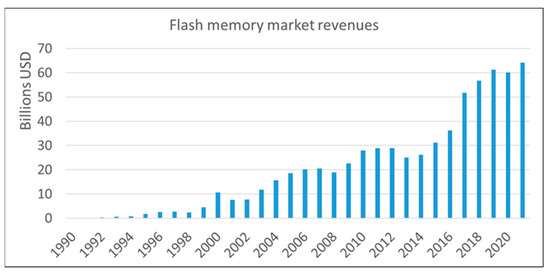
Figure 1
Open AccessReview
Engineering Materials and Devices for the Prevention, Diagnosis, and Treatment of COVID-19 and Infectious Diseases
by
, , , , , , , , and
Nanomaterials 2023, 13(17), 2455; https://doi.org/10.3390/nano13172455 - 30 Aug 2023
Abstract
►▼
Show Figures
Following the global spread of COVID-19, scientists and engineers have adapted technologies and developed new tools to aid in the fight against COVID-19. This review discusses various approaches to engineering biomaterials, devices, and therapeutics, especially at micro and nano levels, for the prevention,
[...] Read more.
Following the global spread of COVID-19, scientists and engineers have adapted technologies and developed new tools to aid in the fight against COVID-19. This review discusses various approaches to engineering biomaterials, devices, and therapeutics, especially at micro and nano levels, for the prevention, diagnosis, and treatment of infectious diseases, such as COVID-19, serving as a resource for scientists to identify specific tools that can be applicable for infectious-disease-related research, technology development, and treatment. From the design and production of equipment critical to first responders and patients using three-dimensional (3D) printing technology to point-of-care devices for rapid diagnosis, these technologies and tools have been essential to address current global needs for the prevention and detection of diseases. Moreover, advancements in organ-on-a-chip platforms provide a valuable platform to not only study infections and disease development in humans but also allow for the screening of more effective therapeutics. In addition, vaccines, the repurposing of approved drugs, biomaterials, drug delivery, and cell therapy are promising approaches for the prevention and treatment of infectious diseases. Following a comprehensive review of all these topics, we discuss unsolved problems and future directions.
Full article
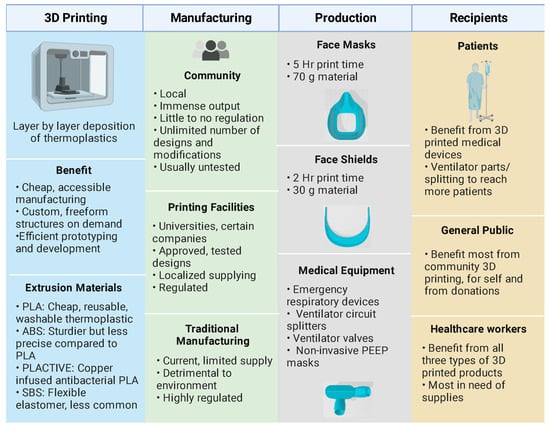
Figure 1
Open AccessArticle
Coherent Spin Dynamics of Electrons in CsPbBr3 Perovskite Nanocrystals at Room Temperature
by
, , , and
Nanomaterials 2023, 13(17), 2454; https://doi.org/10.3390/nano13172454 - 30 Aug 2023
Abstract
Coherent spin dynamics of charge carriers in CsPbBr
Coherent spin dynamics of charge carriers in CsPbBr
(This article belongs to the Special Issue Semiconductor Quantum Dots: Synthesis, Properties and Applications)
►▼
Show Figures
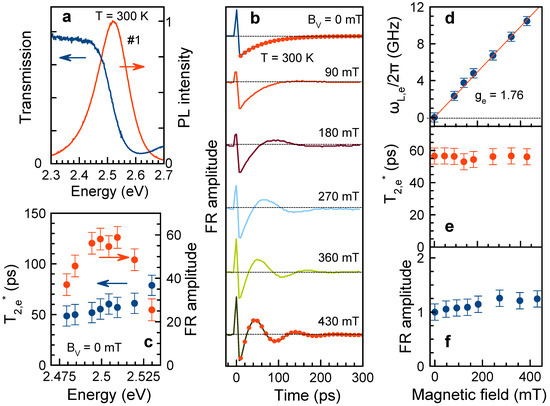
Figure 1
Open AccessArticle
In Situ Fabrication of CdS/Cd(OH)2 for Effective Visible Light-Driven Photocatalysis
Nanomaterials 2023, 13(17), 2453; https://doi.org/10.3390/nano13172453 - 30 Aug 2023
Abstract
Photocatalytic hydrogen production is a promising technology that can generate renewable energy. However, light absorption and fast electron transfer are two main challenges that restrict the practical application of photocatalysis. Moreover, most of the composite photocatalysts that possess better photocatalytic performance are fabricated
[...] Read more.
Photocatalytic hydrogen production is a promising technology that can generate renewable energy. However, light absorption and fast electron transfer are two main challenges that restrict the practical application of photocatalysis. Moreover, most of the composite photocatalysts that possess better photocatalytic performance are fabricated by various methods, many of which are complicated and in which, the key conditions are hard to control. Herein, we developed a simple method to prepare CdS/Cd(OH)2 samples via an in situ synthesis approach during the photocatalytic reaction process. The optimal hydrogen generation rate of CdS/Cd(OH)2 that could be obtained was 15.2 mmol·h−1·g−1, greater than that of CdS, which generates 2.6 mmol·h−1·g−1 under visible light irradiation. Meanwhile, the CdS-3 sample shows superior HER performance during recycling tests and exhibits relatively steady photocatalytic performance in the 10 h experiment. Expanded absorption of visible light, decreased recombination possibility for photo-induced carriers and a more negative conduction band position are mainly responsible for the enhanced photocatalytic hydrogen evolution performance. Photo-induced electrons will be motivated to the conduction band of CdS under the irradiation of visible light and will further transfer to Cd(OH)2 to react with H+ to produce H2. The in situ-formed Cd(OH)2 could effectively facilitate the electron transfer and reduce the recombination possibility of photo-generated electron-hole pairs.
Full article
(This article belongs to the Special Issue Environmental Applications of New Functional Engineering Nanomaterials)
►▼
Show Figures
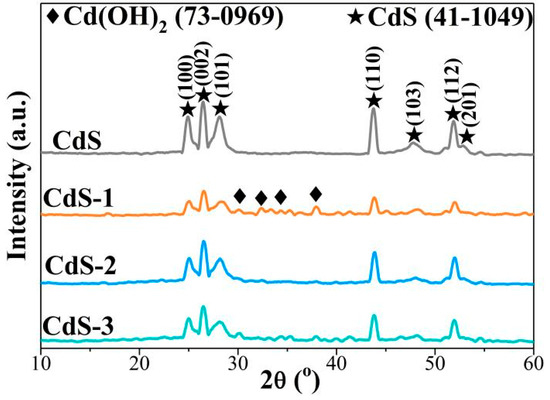
Figure 1
Open AccessArticle
Electrodeposition Synthesis of Coral-like MnCo Selenide Binder-Free Electrodes for Aqueous Asymmetric Supercapacitors
Nanomaterials 2023, 13(17), 2452; https://doi.org/10.3390/nano13172452 - 30 Aug 2023
Abstract
►▼
Show Figures
Bimetallic selenide compounds show great potential as supercapacitor electrode materials in energy storage and conversion applications. In this work, a coral-like MnCo selenide was grown on nickel foam using a facile electrodeposition method to prepare binder-free supercapacitor electrodes. The heating temperature was varied
[...] Read more.
Bimetallic selenide compounds show great potential as supercapacitor electrode materials in energy storage and conversion applications. In this work, a coral-like MnCo selenide was grown on nickel foam using a facile electrodeposition method to prepare binder-free supercapacitor electrodes. The heating temperature was varied to tune the morphology and crystal phase of these electrodes. Excellent electrochemical performance was achieved due to the unique coral-like, dendritic- dispersed structure and a bimetallic synergistic effect, including high specific capacitance (509 C g−1 at 1 A g−1) and outstanding cycling stability (94.3% capacity retention after 5000 cycles). Furthermore, an asymmetric supercapacitor assembled with MnCo selenide as the anode and active carbon as the cathode achieved a high specific energy of 46.2 Wh kg−1 at 800 W kg−1. The work demonstrates that the prepared coral-like MnCo selenide is a highly promising energy storage material.
Full article

Figure 1
Open AccessArticle
Four-Point Measurement Setup for Correlative Microscopy of Nanowires
by
, , , , , , , , , and
Nanomaterials 2023, 13(17), 2451; https://doi.org/10.3390/nano13172451 - 30 Aug 2023
Abstract
The measurement method, which utilizes nanomanipulation of the nanowires onto a specially prepared substrate, was presented. It introduced a four-point resistance measurement setup on a chip suited for scanning probe microscopy measurements, integrating connectors and a nanowire specimen. A study on the resistance
[...] Read more.
The measurement method, which utilizes nanomanipulation of the nanowires onto a specially prepared substrate, was presented. It introduced a four-point resistance measurement setup on a chip suited for scanning probe microscopy measurements, integrating connectors and a nanowire specimen. A study on the resistance and resistivity of the thermally post-treated ZnO nanowires at 200 °C and 300 °C in air showed the dependence of these electrical parameters on the annealing temperature. The investigations of the electrical properties of blocks built on the basis of nanowires and their related devices could provide a useful guide not only for designing, fabricating and optimizing electromechanical nanodevices based on nanowires but also for their safe operation in future electronic applications.
Full article
(This article belongs to the Special Issue Fabrication of Nanoscale Electronics Devices)
►▼
Show Figures
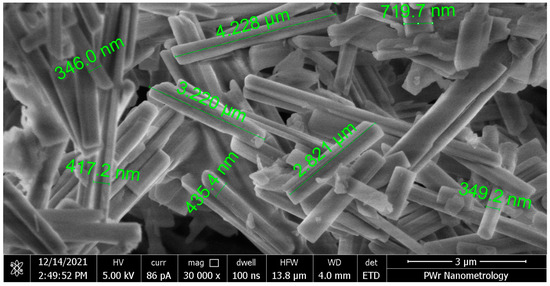
Figure 1

Journal Menu
► ▼ Journal Menu-
- Nanomaterials Home
- Aims & Scope
- Editorial Board
- Reviewer Board
- Topical Advisory Panel
- Instructions for Authors
- Special Issues
- Topics
- Sections & Collections
- Article Processing Charge
- Indexing & Archiving
- Editor’s Choice Articles
- Most Cited & Viewed
- Journal Statistics
- Journal History
- Journal Awards
- Conferences
- Editorial Office
Journal Browser
► ▼ Journal BrowserHighly Accessed Articles
Latest Books
E-Mail Alert
News
Topics
Topic in
Applied Sciences, Fluids, Materials, Nanomaterials, Polymers
Advances and Applications of 2D Materials, 2nd Volume
Topic Editors: Filippo Giannazzo, Ivan ShtepliukDeadline: 30 September 2023
Topic in
Catalysts, Energies, Hydrogen, Molecules, Nanomaterials
Hydrogen Generation, Storage, and Utilization
Topic Editors: In-Hwan Lee, Duy Thanh Tran, Vandung DaoDeadline: 31 October 2023
Topic in
Condensed Matter, Liquids, Nanomaterials, Particles, Photonics, Quantum Reports
Quantum Droplets
Topic Editors: Boris Malomed, Chiara D’Errico, Enguo Chen, Grigori E. AstrakharchikDeadline: 15 November 2023
Topic in
Catalysts, Materials, Molecules, Nanomaterials, Photochem
New Materials and Advanced Applications in Photocatalysis
Topic Editors: Jose L. Hueso, Ewa Kowalska, Zhishun WeiDeadline: 30 November 2023

Conferences
27 October–10 November 2023
The 4th International Electronic Conference on Applied Sciences (ASEC2023)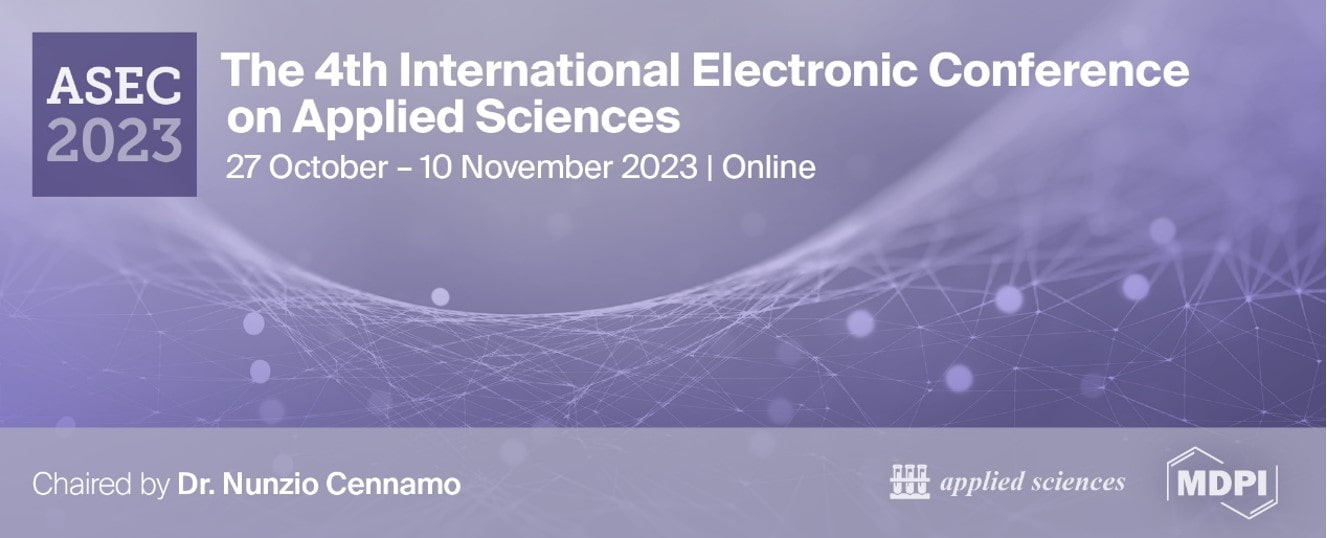

Special Issues
Special Issue in
Nanomaterials
Nanomaterials in Miniaturized Separation and Sensing Devices, Apparatuses and Installations
Guest Editors: Gheorghe Nechifor, Aurelia Cristina NechiforDeadline: 6 September 2023
Special Issue in
Nanomaterials
Design of Nanocatalysts and Electrodes: Application to Fuel Cell and Water Electrolysis
Guest Editor: Namgee JungDeadline: 10 September 2023
Special Issue in
Nanomaterials
Nanomaterials in Foods: Food Additives, Delivery Systems, Detection, and Safety
Guest Editor: Soo-Jin ChoiDeadline: 1 October 2023
Special Issue in
Nanomaterials
Advanced Materials for Lithium (and Post-lithium) Batteries
Guest Editor: Thomas RütherDeadline: 20 October 2023
Topical Collections
Topical Collection in
Nanomaterials
Applications of Magnetic Nanomaterials
Collection Editor: Yurii Gun'ko
Topical Collection in
Nanomaterials
Toxicity of Nanoparticles in the Lung: Environmental and Medical Aspects
Collection Editor: Eleonore Fröhlich
Topical Collection in
Nanomaterials
The Fourth State of Engineering: Nanoengineered Materials and Coatings Facilitated by Plasma Techniques
Collection Editors: Krasimir Vasilev, Kostya (Ken) Ostrikov, Thomas Michl, Akash Bachhuka
Topical Collection in
Nanomaterials
Metallic and Metal Oxide Nanohybrids and Their Applications
Collection Editor: Alexandru Grumezescu




